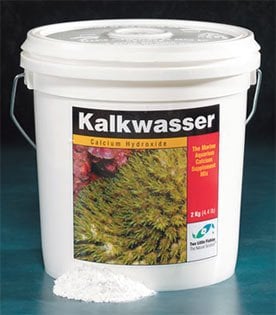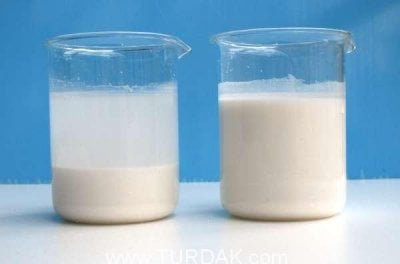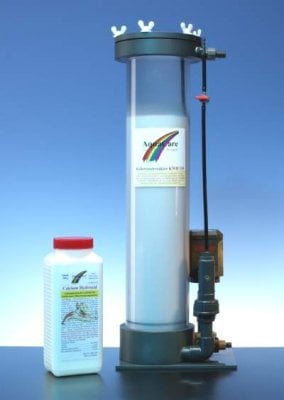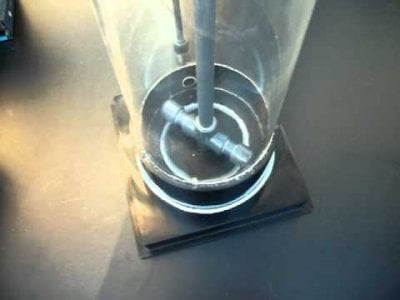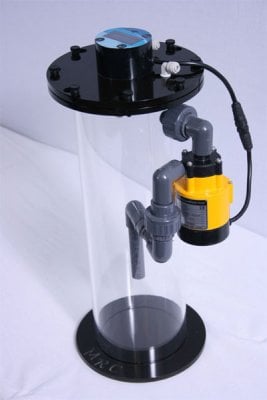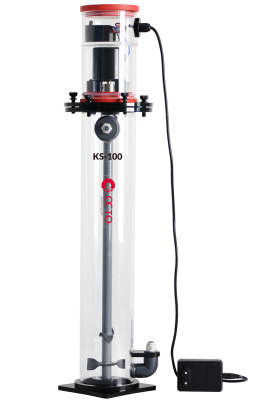All images have been taken from public domain sources and used here under fair use guidelines, as they best illustrate the subject matter.
If you just started keeping a reef aquarium in the past two or three years, chances are you’ve heard about kalkwasser, much in the same way that you’ve heard about wet/dry filters. In an age of two-part additives, advanced automatic dosers and high tech calcium reactors, kalkwasser might be an after-thought to aquarists looking forward and not back. Kalkwasser can be described as old school, as it was one of the original methods used to buffer calcium and carbonate absorption in reef aquariums. Most aquarists today seem to prefer a two-part method, even though reef2reef is loaded with threads about aquarists struggling to buffer ph, carbonate hardness and calcium using two part liquids. Kalkwasser dosing is deceptively simple and also cost efficient. Often, these attributes make something attractive, but in the advanced age of reef-keeping, many new aquarists assume something so easy and inexpensive must be in-effective. However, kalkwasser is quite effective and if properly installed, a kalkwasser reactor (either stirrer or multi-pump reactor) can entirely automate calcium and carbonate dosing while also buffering ph.
Let’s take a walk down memory lane and dive (no pun intended) into this oldie, but goodie. It’s important to remember that while kalkwasser is effective, it doesn’t come without risk. Luckily, with some forethought and planning, those risks can be mitigated, leaving aquarists with a proper ph, calcium and carbonate concentration, that only needs intervention once every few weeks.
What is kalkwasser:
Like I mentioned earlier, most aquarists have heard the term. Kalkwasser is simply a German word for limewater. Not lime as in the tart fruit, but lime as in the hydrogen rich, caustic stuff that exists in everything from cement to fertilizer. Limewater is simply a term that describes a diluted solution of calcium hydroxide. The powder that aquarists purchase labeled kalkwasser, is in fact calcium hydroxide. Ironically, in this usage, the term lime refers to an alkaline solution and not the fruit, which is actually acidic.
In its purest form, kalkwasser is color-less and almost indistinguishable from normal water. It has an earthy smell and a bitter, burning taste. It certainly isn’t something you want to ingest; however, it is used to create various foods (think pickles). Calcium hydroxide powder (the kalkwasser powder we buy) isn’t soluble in water, meaning that it won’t dissolve. The powder remains either suspended in the water column or settles out at the bottom. While this powder loses its effectiveness over-time, it never dissolves. Left to settle at the bottom, calcium hydroxide is rather useless for buffering ph and it needs to be consistently mixed with freshwater to remain useful.
Using calcium hydroxide powder to create limewater:
As I mentioned, settled at the bottom of a reactor, calcium hydroxide powder does little to buffer anything. This is why aquarists implement reactors or stirrers that constantly create limewater. There are two optimal ways to create limewater and both have been used for many, many years in aquarium applications. The newer method involves kalkwasser reactors. These reactors have a feed pump that supplies reverse osmosis freshwater, and multiple circulation pumps that stir the powdery substance, forming a concentrated mixture of limewater. While very effective, these reactors have a fatal flaw. The last thing (and I know from experience) any aquarist wants is limewater slurry entering their aquarium. A safe kalkwasser solution has a ph of about 12 and the slurry has a ph that is so alkaline, it burns coral tissue and causes ph in the aquarium to soar. Since these reactors create a thick kalkwasser slurry, the aquarist has to use a controller to set timers that ensure the reactor won’t run until after the solution has settled. This means programming the reactor’s circulation pumps to run, then to remain off for an extended period of time while the slurry settles. The device that adds kalkwasser to the aquarium must be programmed to wait until the solution is safe. It’s a lot of programming and still not entirely safe. It also severely limits the amount of time during a day that kalkwasser can be implemented, since once the solution settles, it isn’t long before it needs stirred again. Some aquarists swear by reactors, claiming they create a purer mixture of limewater, while others (myself included) see too many risks involved with implementing them.
In this regard, the old way may not only be safer but also more efficient. This involves the use of a kalkwasser stirrer. These are a simple reactor with a water inlet at the bottom and a water outlet at the top. Running vertically through the reactor is a shaft connected to a stirrer. The stirrer can be as simple as horizontal PVC piping or as complex as a series of fins that slowly spin. The shaft and stirrer are connected to an external motor, that spins them either constantly or at pre-programmed intervals. The stirring action breaks up settled kalkwasser powder and ensures it remains in solution. Since the stirrer and water inlet are at the bottom, the top level of the reactor contains solution that is free of any slurry or caustic debris. Since water enters the bottom of the reactor, it’s unlikely any slurry will enter the aquarium if the reactor is properly implemented.
These attributes have allowed kalkwasser stirrers to remain the safest and most effective way of implementing limewater in the aquarium.
Even a stirrer is not safe without programming:
In the early days of aquaria, before the advent of controllers, aquarists usually ran their stirrers 24/7. The pump was always turning the shaft and thus the stirrer was always spinning. While this certainly kept a well-mixed solution on hand, it was overkill and led to premature motor loss. Saturated limewater will remain useful for aquaria for some-time, before all the powder settles out. This means the stirrer doesn’t need to run 24/7, but only for a few minutes every other hour. The average kalkwasser stirrer has a motor life of around 1500 hours. Running constantly throughout a 24-hour day, a stirrer motor will last for less than two-years, which is not a feasible lifetime for a piece of aquarium equipment that costs several hundred dollars. In the old days, aquarists would either replace their kalk-stirrer motor or simply install a new reactor. Considering a good stirrer can cost between 300-500 dollars (depending on aquarium size) this is an expensive proposal.
Using a Neptune Apex (or other controller) the stirrer can easily be programmed to kick on for 15 minutes every two hours. The aquarist still gets a good supply of well saturated limewater and the life of the kalk-stirrer is extended almost indefinitely. I personally have programmed my Apex to kick the kalkwasser stirrer on for 15 minutes every hour. This does require manual programming, and an example of programming that will accomplish this is posted below italicized.
Fallback OFF
Set ON
OSC 000:00/015:00 /045:00 Then ON
If pH > 8.30 Then OFF
This programming tells the Apex that if it reverts into fallback mode (due to control failure, power outage, etc) then the kalk-stirrer turns off. If the OSC (operating system clock) is displaying 15 minutes’ left to the hour, the stirrer kicks on. If the ph of the tank rises to 8.30 the stirrer kicks off as well.
Adding kalkwasser to the tank:
There are several ways to add limewater to the aquarium. By far the most popular method is running the reactor in-line with an auto-top-off system. In this application, each time the ATO system detects a dropping water level and pumps water from the RODI reservoir into the tank, it passes through the kalkwasser stirrer, thus adding limewater to the aquarium. Since ATO’s typically add a small amount of water at random intervals throughout the day, this can be enough to buffer ph and replenish calcium and carbonate. For low to moderate calcium/carbonate demand tanks, this is often enough to maintain proper ph, calcium and carbonate hardness. Though, it comes with some inherent risks. One, if a pump fails or something causes water levels in the tank to suddenly fall, the ATO could pump so much limewater (and eventually kalkwasser slurry) into the tank that it causes a drastic ph rise, wiping out all the animals within the tank. This can easily be prevented by connecting the ATO to a controller and programming the controller to turn off the ATO if ph reaches 8.3.
Even with protective programming, using the ATO to add kalkwasser doesn’t allow much control over how often and how much kalkwasser is added. Even tanks with low calcium/carbonate demand often exhibit falling ph when a kalkwasser stirrer is run in-line with the ATO.
A more effective solution is using a controller to add kalkwasser each time the ph falls. Since limewater has a ph of 12 and is made up of fresh water, it must be added very slowly to prevent any swings in ph or salinity. Something like an aqua-lifter pump works best to add limewater when ph falls, simply because it very slowly adds the solution, drip by drip. The second ph hits the right mark, the pump is kicked off by the controller. Also, a very low gph (gallons per hour) utility pump can be placed in the top-off reservoir and used to pump water through the reactor and into the tank when ph falls. It’s vital to remember that these methods can only work in tanks with low to moderate calcium/carbonate demand because pumping too much freshwater based kalkwasser into the tank each day can rapidly lower salinity, simply circumventing one issue (falling ph) to face another.
Some aquarists add kalkwasser powder directly to their top off water. Kalkwasser loses its effectiveness for altering ph and calcium/carbonate quickly and often this approach does little, as it may be days before that top of water is added to the tank. Having a large volume of kalkwasser powder consistently creating fresh limewater is a more effective method, even though it requires the use of additional equipment.
Final thoughts:
This discussion of limewater and the reactors/stirrers that create it, may make implementing it sound complicated. In reality, it isn’t. If the appropriate precautions are taken, limewater is an easy, effective and safe way to maintain the appropriate level of calcium and carbonate in a reef tank, while also buffering ph to a stable 8.2. It’s vital to ensure that kalkwasser slurry cannot enter the aquarium, so it’s best to under-fill a reactor with powder rather than attempt to over-fill it. If using kalkwasser in conjunction with an ATO, it’s also vitally important to ensure that you have an accurate, reliable and high quality ATO, as it will be deciding when kalkwasser is added to the tank.
If you just started keeping a reef aquarium in the past two or three years, chances are you’ve heard about kalkwasser, much in the same way that you’ve heard about wet/dry filters. In an age of two-part additives, advanced automatic dosers and high tech calcium reactors, kalkwasser might be an after-thought to aquarists looking forward and not back. Kalkwasser can be described as old school, as it was one of the original methods used to buffer calcium and carbonate absorption in reef aquariums. Most aquarists today seem to prefer a two-part method, even though reef2reef is loaded with threads about aquarists struggling to buffer ph, carbonate hardness and calcium using two part liquids. Kalkwasser dosing is deceptively simple and also cost efficient. Often, these attributes make something attractive, but in the advanced age of reef-keeping, many new aquarists assume something so easy and inexpensive must be in-effective. However, kalkwasser is quite effective and if properly installed, a kalkwasser reactor (either stirrer or multi-pump reactor) can entirely automate calcium and carbonate dosing while also buffering ph.
Let’s take a walk down memory lane and dive (no pun intended) into this oldie, but goodie. It’s important to remember that while kalkwasser is effective, it doesn’t come without risk. Luckily, with some forethought and planning, those risks can be mitigated, leaving aquarists with a proper ph, calcium and carbonate concentration, that only needs intervention once every few weeks.
What is kalkwasser:
Like I mentioned earlier, most aquarists have heard the term. Kalkwasser is simply a German word for limewater. Not lime as in the tart fruit, but lime as in the hydrogen rich, caustic stuff that exists in everything from cement to fertilizer. Limewater is simply a term that describes a diluted solution of calcium hydroxide. The powder that aquarists purchase labeled kalkwasser, is in fact calcium hydroxide. Ironically, in this usage, the term lime refers to an alkaline solution and not the fruit, which is actually acidic.
In its purest form, kalkwasser is color-less and almost indistinguishable from normal water. It has an earthy smell and a bitter, burning taste. It certainly isn’t something you want to ingest; however, it is used to create various foods (think pickles). Calcium hydroxide powder (the kalkwasser powder we buy) isn’t soluble in water, meaning that it won’t dissolve. The powder remains either suspended in the water column or settles out at the bottom. While this powder loses its effectiveness over-time, it never dissolves. Left to settle at the bottom, calcium hydroxide is rather useless for buffering ph and it needs to be consistently mixed with freshwater to remain useful.
Using calcium hydroxide powder to create limewater:
As I mentioned, settled at the bottom of a reactor, calcium hydroxide powder does little to buffer anything. This is why aquarists implement reactors or stirrers that constantly create limewater. There are two optimal ways to create limewater and both have been used for many, many years in aquarium applications. The newer method involves kalkwasser reactors. These reactors have a feed pump that supplies reverse osmosis freshwater, and multiple circulation pumps that stir the powdery substance, forming a concentrated mixture of limewater. While very effective, these reactors have a fatal flaw. The last thing (and I know from experience) any aquarist wants is limewater slurry entering their aquarium. A safe kalkwasser solution has a ph of about 12 and the slurry has a ph that is so alkaline, it burns coral tissue and causes ph in the aquarium to soar. Since these reactors create a thick kalkwasser slurry, the aquarist has to use a controller to set timers that ensure the reactor won’t run until after the solution has settled. This means programming the reactor’s circulation pumps to run, then to remain off for an extended period of time while the slurry settles. The device that adds kalkwasser to the aquarium must be programmed to wait until the solution is safe. It’s a lot of programming and still not entirely safe. It also severely limits the amount of time during a day that kalkwasser can be implemented, since once the solution settles, it isn’t long before it needs stirred again. Some aquarists swear by reactors, claiming they create a purer mixture of limewater, while others (myself included) see too many risks involved with implementing them.
In this regard, the old way may not only be safer but also more efficient. This involves the use of a kalkwasser stirrer. These are a simple reactor with a water inlet at the bottom and a water outlet at the top. Running vertically through the reactor is a shaft connected to a stirrer. The stirrer can be as simple as horizontal PVC piping or as complex as a series of fins that slowly spin. The shaft and stirrer are connected to an external motor, that spins them either constantly or at pre-programmed intervals. The stirring action breaks up settled kalkwasser powder and ensures it remains in solution. Since the stirrer and water inlet are at the bottom, the top level of the reactor contains solution that is free of any slurry or caustic debris. Since water enters the bottom of the reactor, it’s unlikely any slurry will enter the aquarium if the reactor is properly implemented.
These attributes have allowed kalkwasser stirrers to remain the safest and most effective way of implementing limewater in the aquarium.
Even a stirrer is not safe without programming:
In the early days of aquaria, before the advent of controllers, aquarists usually ran their stirrers 24/7. The pump was always turning the shaft and thus the stirrer was always spinning. While this certainly kept a well-mixed solution on hand, it was overkill and led to premature motor loss. Saturated limewater will remain useful for aquaria for some-time, before all the powder settles out. This means the stirrer doesn’t need to run 24/7, but only for a few minutes every other hour. The average kalkwasser stirrer has a motor life of around 1500 hours. Running constantly throughout a 24-hour day, a stirrer motor will last for less than two-years, which is not a feasible lifetime for a piece of aquarium equipment that costs several hundred dollars. In the old days, aquarists would either replace their kalk-stirrer motor or simply install a new reactor. Considering a good stirrer can cost between 300-500 dollars (depending on aquarium size) this is an expensive proposal.
Using a Neptune Apex (or other controller) the stirrer can easily be programmed to kick on for 15 minutes every two hours. The aquarist still gets a good supply of well saturated limewater and the life of the kalk-stirrer is extended almost indefinitely. I personally have programmed my Apex to kick the kalkwasser stirrer on for 15 minutes every hour. This does require manual programming, and an example of programming that will accomplish this is posted below italicized.
Fallback OFF
Set ON
OSC 000:00/015:00 /045:00 Then ON
If pH > 8.30 Then OFF
This programming tells the Apex that if it reverts into fallback mode (due to control failure, power outage, etc) then the kalk-stirrer turns off. If the OSC (operating system clock) is displaying 15 minutes’ left to the hour, the stirrer kicks on. If the ph of the tank rises to 8.30 the stirrer kicks off as well.
Adding kalkwasser to the tank:
There are several ways to add limewater to the aquarium. By far the most popular method is running the reactor in-line with an auto-top-off system. In this application, each time the ATO system detects a dropping water level and pumps water from the RODI reservoir into the tank, it passes through the kalkwasser stirrer, thus adding limewater to the aquarium. Since ATO’s typically add a small amount of water at random intervals throughout the day, this can be enough to buffer ph and replenish calcium and carbonate. For low to moderate calcium/carbonate demand tanks, this is often enough to maintain proper ph, calcium and carbonate hardness. Though, it comes with some inherent risks. One, if a pump fails or something causes water levels in the tank to suddenly fall, the ATO could pump so much limewater (and eventually kalkwasser slurry) into the tank that it causes a drastic ph rise, wiping out all the animals within the tank. This can easily be prevented by connecting the ATO to a controller and programming the controller to turn off the ATO if ph reaches 8.3.
Even with protective programming, using the ATO to add kalkwasser doesn’t allow much control over how often and how much kalkwasser is added. Even tanks with low calcium/carbonate demand often exhibit falling ph when a kalkwasser stirrer is run in-line with the ATO.
A more effective solution is using a controller to add kalkwasser each time the ph falls. Since limewater has a ph of 12 and is made up of fresh water, it must be added very slowly to prevent any swings in ph or salinity. Something like an aqua-lifter pump works best to add limewater when ph falls, simply because it very slowly adds the solution, drip by drip. The second ph hits the right mark, the pump is kicked off by the controller. Also, a very low gph (gallons per hour) utility pump can be placed in the top-off reservoir and used to pump water through the reactor and into the tank when ph falls. It’s vital to remember that these methods can only work in tanks with low to moderate calcium/carbonate demand because pumping too much freshwater based kalkwasser into the tank each day can rapidly lower salinity, simply circumventing one issue (falling ph) to face another.
Some aquarists add kalkwasser powder directly to their top off water. Kalkwasser loses its effectiveness for altering ph and calcium/carbonate quickly and often this approach does little, as it may be days before that top of water is added to the tank. Having a large volume of kalkwasser powder consistently creating fresh limewater is a more effective method, even though it requires the use of additional equipment.
Final thoughts:
This discussion of limewater and the reactors/stirrers that create it, may make implementing it sound complicated. In reality, it isn’t. If the appropriate precautions are taken, limewater is an easy, effective and safe way to maintain the appropriate level of calcium and carbonate in a reef tank, while also buffering ph to a stable 8.2. It’s vital to ensure that kalkwasser slurry cannot enter the aquarium, so it’s best to under-fill a reactor with powder rather than attempt to over-fill it. If using kalkwasser in conjunction with an ATO, it’s also vitally important to ensure that you have an accurate, reliable and high quality ATO, as it will be deciding when kalkwasser is added to the tank.



